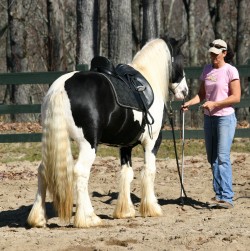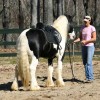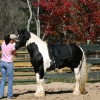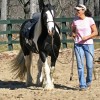
Training Tip #2 from Felicia Britt
- Home
- News & Events
- Gypsy Vanner Blog
- Training Tip #2 from Felicia Britt

Training with Felicia
From the legends of Romulus and Remus to the clash with Carthage during the Punic Wars; from the cruelty of Caligula to the reign of Constantine, the Rome that was once a small agricultural village became one of the largest empires in the Ancient World. Before Attila and his gang, along with some Visigoths and some Vandals sacked the city of Rome herself, this great empire expanded its territory and dominated the Mediterranean for 1200 years. How was this accomplished? By Leadership, Determination, and Skill. The Romans knew that the power lay with the controller of boundaries and the owners of land. So, before I bore you to death with anymore parallels in classical antiquity take hold of the lead rope and think like a Roman, because it is all about territory.
B.R.A.I.N.
UNDERSTANDING BEGINS ON THE GROUND
R – is for ROME
As it is with every creature in the animal kingdom, from children to grandmothers, from chicken to chimps, there is a pecking order which is established by one thing: territory and who controls it. Whether it is a favorite toy, a bargain on the sale table, a juicy, fat worm or a bright banana, someone is going to submit. Your horse is no different. Every time he lifts his head just out of your reach, or hits you with his shoulder, or walks in front of you, or leans on that foot you are breaking your back to pick up to clean, he is controlling his territory and yours. Sometimes it is obvious, and other times so very subtle it may go unnoticed by you. But, to be sure, it is very deliberate on his part. And when we let him use us for a scratching post, we just dropped down so far in the pecking order that even the weanlings are laughing at us!
Before we start on your territorial campaign, I'd like you to keep a few thoughts flashing in the back of your mind.
1) Be Believable: your focus is to convince your horse to trust you, not fear you.
2) Be Brave: your focus is to be honest, not perfect
3) Be Patient: your focus is the process, not the product.
In my view, these are the three most important tools you can take with you to the barn. They build confidence, courage, and self-control in you and your horse.
Unlike people, horses don't care where they are in the herd's hierarchy, as long as they know where they are. It is important to note that while it may not look to you as though the pecking order amongst your horses has changed in the last five years, you can be certain that their positions are re-established daily. That is why your horse will continue to 'check' and see if you are still over him today like you were yesterday. He will actually find new and creative ways to test this regularly, to which you must be prepared to answer consistently every time. How? Move his feet and take his spot of turf, literally.
You can begin with this basic exercise to train your horse to respect your space. Start first by keeping his head off of you. Now, if you just push him away he will think it is a game and he might push you back. To avoid this use one or two fingers to press behind the jaw until your horse moves his head. When he does move, immediately stop the pressure and look away. You will probably have to repeat it many times until he believes you really mean it. Don't quit! Challenge yourself to outlast him. If the lesson today is nothing but to keep his head off of you, then let that be the lesson. If every time he tries to maul you with his head he runs into your fingers, he will stop. With his belief in your commitment (defined as your absolutely-will-not-yield attitude) comes respect. You win. Incidentally, if you don't feel comfortable using your hand, you may certainly use a training stick. Just remember, whether hand or stick, the pressure is touch-press, not POKE.
Once you have the hang of it, hold the pressure behind the jaw longer. Like an immoveable object, hold it there and ask for a bigger commitment on her part. This time you want her to move her head and her front foot. When she steps to the side remove the pressure and look away. You just took your first bit of territory! Practice over and over...pressure, release, pet. Now, when I say 'pet', I don't mean so much affection that her brain turns to oatmeal. Just stroke her briefly to let her know she did what you asked.
At first, allow your goal to be one step to the side. The next day, two steps. Use only as much pressure as it takes for her to learn. Decreasing the pressure gives her a sense of accomplishment. And you, too! Ultimately, you will ask her to do a 360 degree turn without touching her at all. She will simply move out of your way as you take that space. Always, ALWAYS practice on both sides. Count how many times you work on each side and document it in your training journal. It might feel awkward for you on one side or the other, but make yourself do the hard side first. I often find myself purposely schooling on the right side as to educate that eye more, resulting in a much braver horse.
You can apply this exercise to different parts of your horse's body to move her feet and take her territory. Pressure to the flank moves the hip over. Pressure on the chest moves her backward. When she moves like you are asking her to, step into that space, remove the pressure and look away. Then give her a quick pet. Let her rest. Walk her around a bit. Then start again. Control yourself and don't fry her brain.
Lastly, be aware of your body position. For you to communicate clearly, your posture, position, and expression must be consistent with one another. Face your chest the direction you want your horse to go, place pressure on the area you want to yield, look directly at that spot on the horse. When she moves her feet (yields), remove the pressure and look away. This way your hand, body and expression are in unison, communicating a clear message. When your horse finally believes that you are always going to be dominant, she becomes a more secure, trusting partner. When she knows where her position is and can depend on you to be the same every time, the challenges to your authority become fewer and fewer. Eventually, an eye flash from you is all it will take to remind her of her place.
In ROME, we learned that to gain respect you must conquer some territory. What does it take to conquer anything? Confidence, Courage & Self-Control..... and good old-fashioned aggression.
NEXT TIME:
A – AGGRESSION
ASSURANCE NOT ANGER





Comments
julia mark/Dunrovin Gypsy Ranch | posted February 06, 2010
Thanks so much for the imput. Very much like what we do. I really believe a lot of people don’t realize how when we let that cute little foal rest its’ head on our shoulder or turn its’ butt to us to be scratched, we are beginning a path down a slippery slope that will require a lot of retraining in the future.
I look forward to the next installment!
Diane Agnew | posted February 06, 2010
Thank you Felicia - all excellent reminders to me to be consistent, confident and clear when working on the ground with Buster my Vanner who looks similar to pony in the photo above. Look forward to next newsletter tip.
Di (Scotland UK)
Robin | posted February 06, 2010
Thanks for your comments Julia and Diane! I have forwarded them on to Felicia!
Felicia Britt | posted February 07, 2010
Hi guys! Thank you for sharing your thoughts. You are absolutely right, Julia, those foals can be irresistable sometimes. Please know, that affection certainly has its place and anyone that sees me training a horse knows I give some serious ‘head hugs’; but even that was taught with mutual respect. Boundaries must be established first. My equine students have learned that such favor from me is a huge reward and when they have earned it, their pride is evident and they know it’s a big deal. That moment is equally satifying for both of us. It is sort of like your 3rd teacher waiting until the last day of school to tell you what a nice student you are(true story). That would garner so much more respect than the teacher that patted your head everyday, whether you earned it or not.
And, Diane, truer words were never spoken. We all need reminders…especially me! That was the singular reason I began, many years ago, to keep a journal on every horse I train. It has become an invaluable tool for me. So, I encourage each of you to write down what you are doing with your horse and how he is progressing. Don’t forget to document how you are doing as well. If you already are, GREAT! Let me know how it is going. Send me a photo of you and your partner. .(JavaScript must be enabled to view this email address)
Margery Wentworth | posted February 07, 2010
Hi Felicia, I was excited to find your email and what your training advise is exactly what I’m trying to do with LOKI, my 5 year old norwegian fjord who I’m doing some parelli training particularly ground work keeping him out of my space and trying to gain confidence and trust creating a connection for the two of us. Pressure and release is so important that I know has already transferred to the saddle. Also I’m using treats as a bonus not a bribe and that has really helped since he’s so food motivated.
One thing that has helped with leadership is doing a treasure hunt and placing carrots on the stumps in his 3 acrea pasture and then properly leading him—with most of the time successfully showing leadership and gaining his respect. I look forward to more of your training advise. My best to Robin.
Rhonda Cofer | posted February 07, 2010
Love this, if I remember correctly this was one of our first lessons when you came here Felicia and has been a godsend. Thanks Robin for having this on your site. Thanks Felicia for reminding us of our place in the herd!
Hi Margery! It sounds like you are having fun with your new boy!
Carol Dunbar | posted February 08, 2010
Felicia and Robin,
What a wonderful idea for a blog! I don’t recall seeing the first one but love it. With so many of our owners so new to horses, your word pictures were precise and very clear making it easy to put into action. This is the very sort of thing that has been needed all along.
Good Job!
Carol
Felicia Britt | posted February 09, 2010
Hi Margery! So glad to hear your training is going well. The beauty of intense and precise ground work is that it transfers seamlessly to undersaddle work, if done correctly. When I teach young colts to sidepass on the ground, I add a verbal cue as well. Then, when I am mounted, the physical pressure is the same and the verbal cue makes the horse think, “Hmm….you’ve never asked me to do that while you were on my back before, but I know what that word means, so I will give it a try.” He steps to the side, you release all pressure and allow him to walk in the direction you were going, ie. sidepass to the right, then turn to the right. The release and ‘keep moving’ lets him know he was correct. I try to use as many senses as possible to teach an element, then as he matures, refine it to an indiscernable cue.
Oh, and I was wondering. Is Loki as mischievous as his namesake?
Felicia Britt | posted February 09, 2010
Hey Carol,
Thank you for your words of encouragement regarding new horse owners. Although I train students,and their horses, at all levels, my heart is truly with the novice who is sometimes overwhelmed and often slips through the cracks in the horse business. Whether a show horse or a yard ornament, (and I have both); ultimately, it is about an intimate relationship between human and horse that is intricately interwoven into the fabric of their friendship. Therein lies the reward.
ps. Contact me: .(JavaScript must be enabled to view this email address) and I would be happy to send you the first installment of B.R.A.I.N. Understanding Begins on the Ground
Heather | posted February 24, 2010
Am new to horses although have loved them all my life. I have been taking lessons for a number of months now and am enjoying it thoroughly. I read your “R” installment but missed the “B”. I found it really helpful with the horse I am working with as it is a learning curve for both of us! The Gypsy Vanners are a beautiful horse…I have always been partial to Clydesdales and Paints and these magnificent horses seem to have both of my faves. Thanks for the information, looking forward to the next one.
Heather
Felicia Britt | posted February 25, 2010
Hello Heather,
Welcome to the world of horses! I am glad to hear your lessons are going well and that you are having fun. Enjoyment is key. I am pleased to know my training tips have been helpful. The first installment ( B.) is listed under the Gypsy Vanner Blog, if you would like to read it.
One of my quarter horse clients is considering a Clydesdale. What an adventure! Good luck with your training and remember to focus on the process and the product will come naturally.
Take care,
Felicia